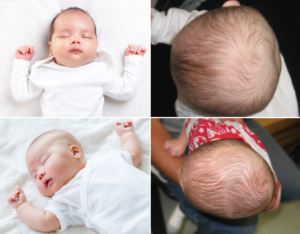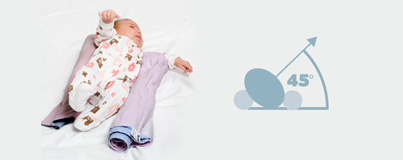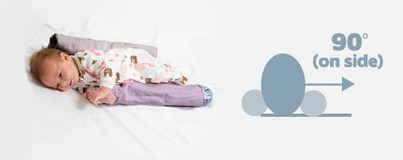- Baby Blues
- Changes in Your Body After Giving Birth
- Grandparents and the New Baby
- Infant Attachment
- Jealousy and Sibling Rivalry: Newborn Edition
- New Dad
- Newborn Routine Practices and Tests
- Preventing Baby Flat Head
- Shaken Baby Syndrome
- Taking Care Of Your Mental Health While Expecting And Caring For A Baby
- Tummy Time
Preventing Baby Flat Head
Baby flat head happens when a baby’s skull becomes flattened due to forces acting on the skull. A baby can have a flat head when they are born (caused by their position in the belly or the birth process) or can develop flat head later (caused by the surfaces they lay on).
There are many ways to prevent baby flat head.
1. Alternate your baby’s head position when they are sleeping
The Canadian Pediatric Society recommends that infants sleep on their back at nighttime. One of the biggest risk factors for developing flat head is a baby that keeps their neck in the same position when asleep. To help prevent baby flat head, simply try to alternate your baby’s head position each time they go to sleep. Turn their neck to the left for one sleep and to the right for another.
If your baby wakes frequently throughout the night, alternate their head position each time they go back to sleep.
2. Ensure your baby can turn their neck fully in both directions

It is common for young babies to prefer to look in one direction when they are lying on their backs – they may have stronger or tighter muscles on one side. If you notice this with your baby, try to encourage them to look to the less preferred side by using brightly colored toys or your face. This will help to strengthen the muscles on that side.
If your baby is unable to turn their head to both sides you should discuss this with your doctor or public health nurse.
3. Limit the amount of time that your baby spends in equipment
Extended use of equipment such as car seats, swings, and bouncy chairs can contribute to flat head as the baby’s head is resting on a hard surface. Limit the use of such equipment to only when necessary. If they fall asleep in equipment, move them to a crib, cradle, or bassinet as soon as it is possible and safe to do so.
4. Give your baby tummy time
Tummy Time is the period of time during the day when your baby is awake and supervised while on their stomach. This helps to strengthen the baby’s neck and upper body.
Babies should get a total of least 30 minutes of tummy time a day from the time they are sent home from the hospital (unless otherwise instructed by your doctor).
Visit the Tummy Time page to learn more.
What causes baby flat head?
A baby is most at risk to develop a flat head in the first four months of life. A newborn baby’s skull bones are soft and thin to allow for easier passage through the birth canal. This makes the skull of a young baby more moldable. In addition to this, a younger baby is not yet strong enough to roll or change their position on their own. One of the main risk factors for flat head is when the baby sleeps with their head in the same position.
baby is most at risk to develop a flat head in the first four months of life. A newborn baby’s skull bones are soft and thin to allow for easier passage through the birth canal. This makes the skull of a young baby more moldable. In addition to this, a younger baby is not yet strong enough to roll or change their position on their own. One of the main risk factors for flat head is when the baby sleeps with their head in the same position.
A baby who sleeps with their head in the middle is at risk of getting flatness on the back of their skull. If your baby tends to keep their neck turned to the left or right when sleeping, they are at risk of developing flatness on one side of their head.
While baby flat head does not affect the development of the baby’s brain, it can affect the baby’s appearance. If not diagnosed and treated early, the skull and face bone changes can be permanent.
More information
My baby already has a flat head (click to expand) »If your baby develops a flat spot, you can change the shape of the baby’s head by using repositioning techniques. Repositioning is most effective when started in the early months of life. Repositioning takes pressure off the flat spot so your baby’s head can round out as the head grows. For example, if your baby has a flat spot on the right side of their head, try to keep their head turned to the left when they are asleep on all surfaces. |
What do I do if my baby will not keep their heads turned in the opposite direction of the flattening? (click to expand) »If your baby will not keep their head turned in the opposite direction to keep the pressure off the flat side, below are some tips for how to safely work on reshaping the head using closely supervised sleep.
The earlier the positioning is started the better chance that the baby’s head shape will improve. |
Services related to this information:
- Contact your Public Health Nurse.
- Physiotherapy, Janeway Health and Rehabilitation Centre – 709-777-4346
- 811 HealthLine (Newfoundland & Labrador) – Call 811 or 1-888-709-2929 / TTY 1-888-709-3555



 For babies with a flat spot on the side of their heads:
For babies with a flat spot on the side of their heads: For babies with a flat spot on the back of their heads:
For babies with a flat spot on the back of their heads: